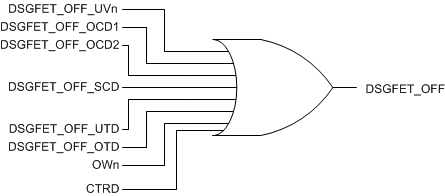ZHCSF60K June 2016 – July 2020 BQ77904 , BQ77905
PRODUCTION DATA
- 1 特性
- 2 应用
- 3 说明
- 4 Revision History
- 5 Device Comparison
- 6 Pin Configuration and Functions
- 7 Specifications
-
8 Detailed Description
- 8.1 Overview
- 8.2 Functional Block Diagram
- 8.3
Feature Description
- 8.3.1 Protection Summary
- 8.3.2
Fault Operation
- 8.3.2.1 Operation in OV
- 8.3.2.2 Operation in UV
- 8.3.2.3 Operation in OW
- 8.3.2.4 Operation in OCD1
- 8.3.2.5 Operation in OCD2
- 8.3.2.6 Operation in SCD
- 8.3.2.7 Overcurrent Recovery Timer
- 8.3.2.8 Load Removal Detection
- 8.3.2.9 Load Removal Detection in UV
- 8.3.2.10 Operation in OTC
- 8.3.2.11 Operation in OTD
- 8.3.2.12 Operation in UTC
- 8.3.2.13 Operation in UTD
- 8.3.3 Protection Response and Recovery Summary
- 8.3.4 Configuration CRC Check and Comparator Built-In-Self-Test
- 8.3.5 Fault Detection Method
- 8.3.6 State Comparator
- 8.3.7 DSG FET Driver Operation
- 8.3.8 CHG FET Driver Operation
- 8.3.9 External Override of CHG and DSG Drivers
- 8.3.10 Configuring 3-S, 4-S, or 5-S Mode
- 8.3.11 Stacking Implementations
- 8.3.12 Zero-Volt Battery Charging Inhibition
- 8.4 Device Functional Modes
- 9 Application and Implementation
- 10Power Supply Recommendations
- 11Layout
- 12Device and Documentation Support
- 13Mechanical, Packaging, and Orderable Information
8.3.7 DSG FET Driver Operation
The DSG pin is driven high only when no related faults (UV, OW, OTD, UTD, OCD1, OCD2, SCD, and CTRD are disabled) are present. It is a fast switching driver with a target on resistance of about 15–20 Ω and an off resistance of RDSGOFF. It is designed to allow users to select the optimized RGS value to archive the desirable FET rise and fall time per the application requirement and the choice of FET characteristics. When the DSG FET is turned off, the DSG pin drives low and all overcurrent protections (OCD1, OCD2, SCD) are disabled to better conserve power. These resume operation when the DSF FET is turned on. The device provides FET body diode protection through the state comparator if one FET driver is on and the other FET driver is off.
The DSG driver may be turned on to prevent FET damage if the battery pack is charging while a discharge inhibit fault condition is present. This is done with the state comparator. The state comparator (with the VSTATE_C threshold) remains on for the entire duration of a DSG fault with no CHG fault event.
- If (SRP-SRN) ≤ VSTATE_C and no charge event is detected, the DSG FET output will remain OFF due to the present of a DSG fault.
- If (SRP-SRN) > VSTATE_C and a charge event is detected, the DSG FET output will turn ON for body diode protection.
See the Section 8.3.6 section for details.
The presence of any related faults, as shown in Figure 8-6, results in the DSGFET_OFF signal .
 Figure 8-6 Faults that Can Qualify DSGFET_OFF
Figure 8-6 Faults that Can Qualify DSGFET_OFF